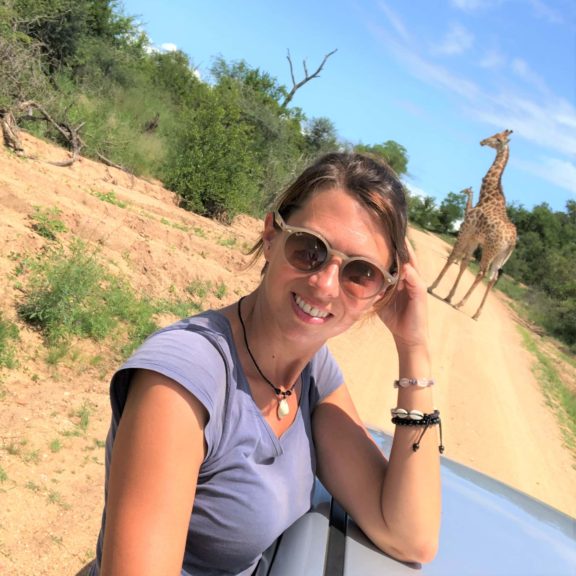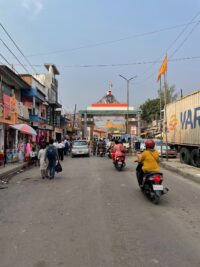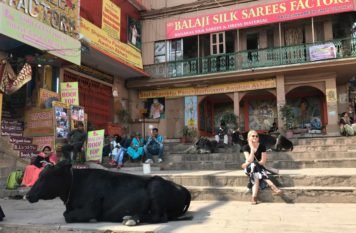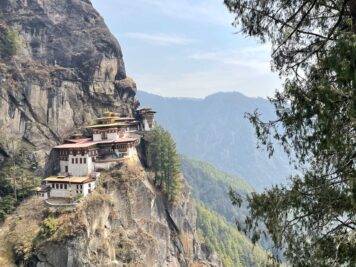It took us two attempts to get to Cotonou, the biggest city in Benin. We got up early one morning and easily found a share taxi to take us the short distance from Ouidah.
We’ve noticed that some of our rides here seem to begin with a fight. Interestingly enough, it’s not a dispute between us and the driver over an insanely inflated fare, but rather between the driver and some zealous individual on the side of the road providing an unasked-for service, such as checking the tire air pressure while the driver is trying to pull out into traffic, or touting for passengers and then demanding a steeper cut than the driver is prepared to give. On a couple of occasions we’ve witnessed a vicious argument between such an assistant and a driver, ended by the driver screaming ‘Leave me alone!’ (or similar, in French) and peeling off, the two of us snickering in the backseat. This morning was no exception, other than the fact that the helpful individual in question picked up a large, heavy jagged rock and made to throw it at the passenger window, which resulted in less snickering from us and a lot more slithering down in our seats.
After that it was smooth sailing, rattling around in the back of a rusty car and then, with the addition of a few more passengers (hence the name ‘share-taxi’) squeezed in tightly, there was a lot less rattling. If the car were to overturn I don’t think a single one of us would budge.
The approach into the sprawling city was endless and when the car finally stopped we were in the thick of a congested marketplace festering with people, vehicles, and flapping squawking chickens. For the women who work there it was just another day to sell eggs, vegetables, oil, towels, bedsheets and plastic kettles and pots but for us it was an abrupt start to the morning – and without any coffee first, either. Adding to the general confusion was a makeshift marching band, going from market stall to market stall, playing brass instruments loudly and exuberantly.

That was all very well, but the whole scene was one of sensory overload. Travelling like this and making plans as we go, we’ve learned to expect the unexpected. We sometimes make decisions on the spur of the moment – and so, you win some and you lose some. An amazing place can disrupt our progress because we just don’t ever want to leave it behind. And on the other hand we’ve also ended up in some less loveable places we can’t wait to leave – and this felt like one of them. Over the ceaseless racket we agreed to leave town immediately on the next bush-taxi (minibus) bound for Porto Novo.

A slave trading post founded by the Portugese in the 1500s, Porto Novo is now Benin’s much more sedate capital city. We checked into the Beaurivage, a hotel very clearly at the end of its less-than-exalted lifetime (much like the faded city itself). Complete with flaking paint, peeling lineoleum, a musty smell and infrequent running water, the hotel also offered no electricity other than a couple of hours at night when a generator sputtered to life and the few lights which actually still worked (those with lightbulbs in place, anyway) flickered weakly. It’s one of the better options in town.

The front desk manager, a sweet old man wearing a motorcycle helmet, showed us around. It was one of the livlier options in town, too – and that’s saying a lot as we were the only guests. It was just like ‘The Shining’ only without the snow and nobody breaking down our door with an axe. Actually the motorcyle-helmet-wearing old man and his younger, helmet-less assistant were extremely friendly and helpful and it was a perfectly comfortable place to stay. A win, even, you might say (we did).
No electricity, a lot of dust and some dirt – we were just fine with all that. Porto Novo is sleepy and friendly and we weren’t ready to deal with the sweaty madness in Cotonou yet. We took a walk; Oyv played foozball with some kids; we sat at a maquis and tried different beers on tips from the chatty locals already sitting there.


But the next day we got up and went back to Cotonou. We didn’t want to go there (twice, no less) because it’s a really nice city. It isn’t. But we wanted to go to a village called Ganvie, and the best way to get there was via Cotonou, so back we went. This time, having already taken a running start, it really wasn’t so bad and we found our way to a guesthouse.
And then we flagged ourselves a moto and headed out for the day. Speaking of motos (and our near-constant use of them as a means of transport) our matching motorcycle helmets that we brought from home have drawn some hilarity; or maybe it’s just the fact that we insist on wearing them at all. But by now more than one driver has asked us to give him the helmet in exchange for a ride. It’s yet another reminder of us how an easy and inexpensive purchase for us is out of reach for so many others who really need it, and we’d gladly donate them – except that we need them ourselves, every day on this trip. They take up a lot of space in our backpacks but let’s face it, if we can make room for a couple bottles of wine we can make room for helmets.
Our moto deposited us at the end of a long rickety pier on the edge of Lake Nokoue, where we boarded a pirogue (a wooden dugout canoe) bound for Ganvie. More than a village; Ganvie is a whole way of life.



First established in the 1700s as a place to hide from slavers, this entire fishing village is built on stilts over the lake seven kilometers from land and screened by frothy green vegetation. Around 25 000 Tofinu people live in the rather ramshackle bamboo huts that last around twenty years before they need rebuilding. Like any other village there are churches, schools, shops and other communal buildings. But unlike most other villages these buildings teeter over streets and lanes of lake water, surrounded by fish farms, with a floating marketplace in the middle.



Instead of a motorbike each family’s vehicle is a pirogue – and the village is a lot quieter for it, a world away from the snarled traffic in Cotonou. Men fish from the pirogues; women use them to ferry fish to the city markets for sale; kids paddle them to the central pump where they fill big plastic buckets with drinking water every day.




And of course, even in a stilt village built on a lake, there are familiar sights too:

If you were to paddle far enough down this lake you’d eventually find yourself in Nigeria. After fishing, smuggling petrol from Nigeria to Benin is Ganvie’s second biggest industry.
So Cotonou turned out to be a win after all. And then we relentlessly travelled onwards, to Abomey.
We went to Abomey because we’d read good things about the Dahomeyan palaces there which all turned out to be completely false or else written by someone who has pretty low expectations for a good day out, and a superhuman tolerance for boredom. The palaces were closed to the public and far from impressive anyway, each one set in a muddy field of rubbish, left running to ruin, the doors chained shut.


The guide we hired recounted a mind-numbing litany of Kings and their countless wives and sons in an obvious attempt to drag the time out and raise the cost. The best part of the day was when our guide’s climb down yet another King’s family tree was drowned out by the shrieks and groans of a very drunk man lying on the ground outside one of the palaces.
Although there were some interesting bas-reliefs, like this one:

Abomey was a nice town to base ourselves in but the palaces were a sight we wished we’d not seen. Over dinner that night, we decided touring the palaces of Abomey belonged on our (thankfully, very) short list of travel experiences we’d rather forget. We ranked it following the Kathakali dancing we’d been unfortunate enough to witness in southern India, and just edging out the famous water puppets show we’d seen more than a decade ago in Vietnam and have been trying to put behind us ever since.
But, as they say – you win some, you lose some.
Read More
For more of our adventures (and misadventures) in Benin, check out the rest of my stories from the road.



